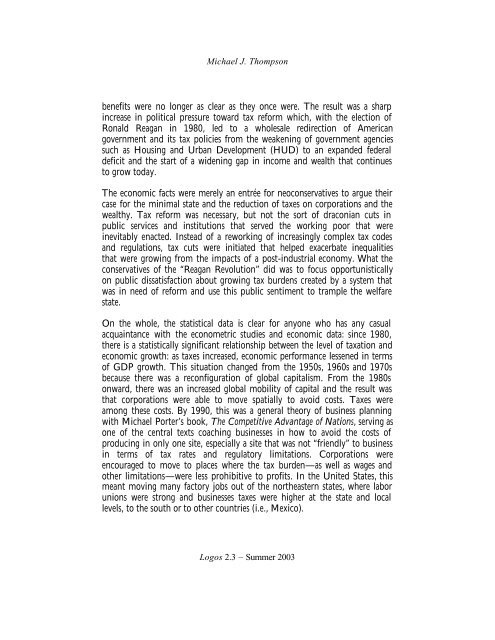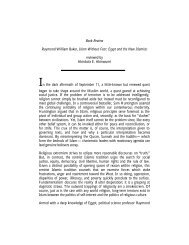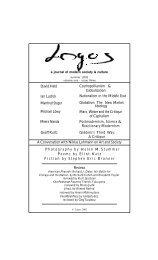Michael J. Thompson Stephen Eric Bronner Wadood Hamad - Logos
Michael J. Thompson Stephen Eric Bronner Wadood Hamad - Logos
Michael J. Thompson Stephen Eric Bronner Wadood Hamad - Logos
Create successful ePaper yourself
Turn your PDF publications into a flip-book with our unique Google optimized e-Paper software.
<strong>Michael</strong> J. <strong>Thompson</strong><br />
benefits were no longer as clear as they once were. The result was a sharp<br />
increase in political pressure toward tax reform which, with the election of<br />
Ronald Reagan in 1980, led to a wholesale redirection of American<br />
government and its tax policies from the weakening of government agencies<br />
such as Housing and Urban Development (HUD) to an expanded federal<br />
deficit and the start of a widening gap in income and wealth that continues<br />
to grow today.<br />
The economic facts were merely an entrée for neoconservatives to argue their<br />
case for the minimal state and the reduction of taxes on corporations and the<br />
wealthy. Tax reform was necessary, but not the sort of draconian cuts in<br />
public services and institutions that served the working poor that were<br />
inevitably enacted. Instead of a reworking of increasingly complex tax codes<br />
and regulations, tax cuts were initiated that helped exacerbate inequalities<br />
that were growing from the impacts of a post-industrial economy. What the<br />
conservatives of the “Reagan Revolution” did was to focus opportunistically<br />
on public dissatisfaction about growing tax burdens created by a system that<br />
was in need of reform and use this public sentiment to trample the welfare<br />
state.<br />
On the whole, the statistical data is clear for anyone who has any casual<br />
acquaintance with the econometric studies and economic data: since 1980,<br />
there is a statistically significant relationship between the level of taxation and<br />
economic growth: as taxes increased, economic performance lessened in terms<br />
of GDP growth. This situation changed from the 1950s, 1960s and 1970s<br />
because there was a reconfiguration of global capitalism. From the 1980s<br />
onward, there was an increased global mobility of capital and the result was<br />
that corporations were able to move spatially to avoid costs. Taxes were<br />
among these costs. By 1990, this was a general theory of business planning<br />
with <strong>Michael</strong> Porter’s book, The Competitive Advantage of Nations, serving as<br />
one of the central texts coaching businesses in how to avoid the costs of<br />
producing in only one site, especially a site that was not “friendly” to business<br />
in terms of tax rates and regulatory limitations. Corporations were<br />
encouraged to move to places where the tax burden—as well as wages and<br />
other limitations—were less prohibitive to profits. In the United States, this<br />
meant moving many factory jobs out of the northeastern states, where labor<br />
unions were strong and businesses taxes were higher at the state and local<br />
levels, to the south or to other countries (i.e., Mexico).<br />
<strong>Logos</strong> 2.3 – Summer 2003




